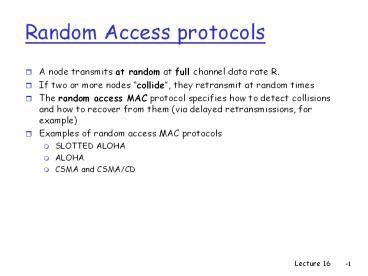Random Access protocols - PowerPoint PPT Presentation
Title:
Random Access protocols
Description:
if collision occurs (assume channel feedback, eg the receiver informs the source ... Collision probability increases (packet can collide with other packets which are ... – PowerPoint PPT presentation
Number of Views:1571
Avg rating:3.0/5.0
Title: Random Access protocols
1
Random Access protocols
- A node transmits at random at full channel data
rate R. - If two or more nodes collide, they retransmit
at random times - The random access MAC protocol specifies how to
detect collisions and how to recover from them
(via delayed retransmissions, for example) - Examples of random access MAC protocols
- SLOTTED ALOHA
- ALOHA
- CSMA and CSMA/CD
2
Slotted Aloha
- Time is divided into equal size slots ( sending
one frame) - a newly arriving station transmits at the
beginning of the next slot - if collision occurs (assume channel feedback, eg
the receiver informs the source of a collision),
the source retransmits the packet at each slot
with probability P, until successful. - Success (S), Collision (C), Empty (E) slots
- Fully decentralized
3
Slotted Aloha efficiency
- If N stations always have frames to send, and
each transmits in each slot with probability P,
the probability of successful transmission S is - S Prob (only one transmits) N P
(1-P)(N-1) - Optimal value of P P 1/N
- For example, if N2, S .5
- For N very large one finds S 1/e
(approximately, .37)
4
Pure (unslotted) ALOHA
- Slotted ALOHA requires slot synchronization
- A simpler version, pure ALOHA, does not require
slots - A node transmits without awaiting for the
beginning of a slot - Collision probability increases (packet can
collide with other packets which are transmitted
within a window twice as large as in S-Aloha) - Throughput is reduced by one half, S 1/2e
5
CSMA (Carrier Sense Multiple Access)
- CSMA listen before transmit. If channel is
sensed busy, defer transmission - Persistent CSMA retry immediately when channel
becomes idle (this may cause instability) - Non persistent CSMA retry after random interval
of time - Note collisions may still exist, since two
stations may sense the channel idle at the same
time ( or better, within a vulnerable window
round trip delay) - In case of collision, the entire pkt transmission
time is wasted
6
CSMA collisions
7
CSMA/CD (Collision Detection)
- CSMA/CD like in CSMA
- collisions are detected within a few bit times
- Transmission is then aborted, reducing the
channel wastage considerably - persistent retransmission is implemented
- Collision detection is easy in wired LANs
- can measure signal strength on the line
- Collision detection cannot be done in wireless
LANs - CSMA/CD can approach channel utilization 1 in
LANs - low ratio of propagation over frame transmission
time
8
CSMA/CD collision detection
9
Taking Turns MAC protocolsRecall the first 2
types of MAC Protocols
- channel partitioning MAC protocols TDM, FDM and
CDMA - can share channel fairly
- - a single station cannot use it all
- Random access MAC protocols
- a single station can use full channel rate
- - cannot share the channel fairly
- Third type of MAC protocol is Taking Turns
protocol - Taking Turns MAC protocols
- Achieve both fair and full rate
- with some extra control overhead
- (a) Polling Master invites slaves
- - Request/Clear overhead, latency, single point
of failure - (b) Token passing token is passed from one
node to the next - Reduce latency, improve fault tolerance
- - elaborate procedures to recover from lost
token
10
LAN technologies
- MAC protocols used in LANs, to control access to
the channel - Token Rings IEEE 802.5 (IBM token ring), for
computer room, or Department connectivity, up to
16Mbps FDDI (Fiber Distributed Data Interface),
for Campus and Metro connectivity, up to 200
stations, at 100Mbps. - Ethernets employ the CSMA/CD protocol 10Mbps
(IEEE 802.3), Fast E-net (100Mbps), Giga E-net
(1,000 Mbps) by far the most popular LAN
technology
11
LAN Addresses and ARP
- IP address drives the packet to destination
network - LAN (or MAC or Physical) address drives the
packet to the destination nodes LAN interface
card on the local LAN - 48 bit MAC address (for most LANs) burned in the
adapter ROM (alias Ethernet address, alias
physical address)
12
LAN Address (cont)
- MAC address allocation administered by IEEE
- A manufacturer buys a portion of the address
space - to assure uniqueness
- Analogy
- (a) MAC address like Social Security
Number - (b) IP address like postal address
- MAC flat address gt portability
- IP hierarchical address NOT portable (need mobile
IP) - Broadcast LAN address 1111.1111
(FF-FF-FF-FF-FF-FF)
13
ARP Address Resolution Protocol
- Each IP node (Host, Router) on the LAN has ARP
module and Table - ARP Table IP/MAC address mappings for some LAN
nodes - lt IP address MAC address
TTLgt - lt .. gt
- TTL (Time To Live) timer, typically 20 min
14
ARP (cont)
- Host A wants to send packet to destination IP
addr XYZ on same LAN - Source Host first checks own ARP Table for IP
addr XYZ - If XYZ not in the ARP Table, ARP module
broadcasts ARP pkt - lt XYZ, MAC (?) gt
- ALL nodes on the LAN accept and inspect the ARP
pkt - Node XYZ responds with unicast ARP pkt carrying
own MAC addr - lt XYZ, MAC (XYZ) gt
- MAC address cached in ARP Table
15
Routing pkt to another LAN
- Say, route packet from source IP addr
lt111.111.111.111gt to destination addr
lt222.222.222.222gt - In routing table at source Host, find router
111.111.111.110 - In ARP table at source, find MAC address
E6-E9-00-17-BB-4B, etc

